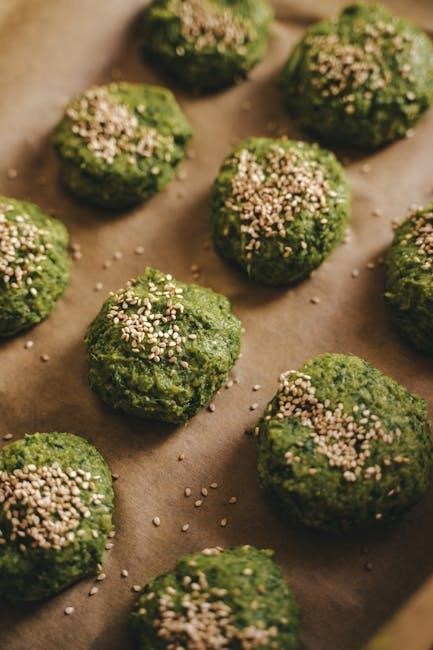GERD, or gastroesophageal reflux disease, is a chronic condition where stomach acid flows back into the esophagus, causing discomfort․ Diet plays a crucial role in managing symptoms, as certain foods can trigger acid reflux․ Understanding which foods to avoid and adopting healthier eating habits can significantly reduce discomfort and improve quality of life․
1․1 What is GERD?
GERD, or gastroesophageal reflux disease, is a chronic condition where stomach acid frequently flows back into the esophagus, causing irritation and discomfort․ This occurs when the lower esophageal sphincter (LES), a muscular ring that separates the esophagus and stomach, weakens or fails to close properly․ Over time, this repeated exposure to acidic stomach contents can lead to inflammation and damage in the esophagus․ Common symptoms of GERD include heartburn, chest pain, difficulty swallowing, and regurgitation of food․ If left unmanaged, GERD can lead to complications such as esophagitis, strictures, or even Barrett’s esophagus, a precancerous condition․ While GERD can affect anyone, factors like obesity, smoking, and certain dietary choices increase the risk․ Managing the condition often involves lifestyle changes, including dietary adjustments, to reduce acid reflux episodes and alleviate symptoms․ Understanding the relationship between diet and GERD is essential for developing an effective management plan․
1․2 The Role of Diet in Managing GERD
Diet plays a central role in managing GERD, as certain foods and eating habits can trigger or worsen acid reflux symptoms․ By identifying and avoiding trigger foods, individuals can significantly reduce the frequency and severity of GERD episodes․ Foods like fatty or fried items, citrus fruits, tomatoes, chocolate, and spicy dishes often relax the lower esophageal sphincter (LES) or delay stomach emptying, allowing acid to flow back into the esophagus․ Additionally, consuming large meals or lying down immediately after eating can exacerbate symptoms․ Adopting a GERD-friendly diet involves making mindful choices, such as opting for smaller, more frequent meals and avoiding late-night eating․ Drinking plenty of water and incorporating alkaline-rich foods can also help neutralize stomach acid․ By tailoring dietary habits to individual triggers, individuals with GERD can better control their symptoms and improve their overall quality of life․ This personalized approach, combined with lifestyle modifications, is often the first line of defense against GERD․

Foods That Trigger Acid Reflux
Certain foods can trigger acid reflux by relaxing the lower esophageal sphincter or delaying stomach emptying, allowing acid to flow back into the esophagus․ Common culprits include fatty, fried, and spicy foods, as well as citrus fruits, tomatoes, chocolate, and mint․

2․1 Fatty and Fried Foods
Fatty and fried foods are among the top triggers for acid reflux due to their high fat content, which slows digestion and delays stomach emptying․ This prolonged digestion allows stomach acid more time to flow back into the esophagus, causing discomfort․ Examples include fried foods like french fries, processed meats, and rich desserts․ These foods also weaken the lower esophageal sphincter, further exacerbating symptoms․ To manage GERD, it’s best to limit or avoid these foods and opt for leaner, grilled, or baked alternatives․

2․2 Citrus Fruits and Tomatoes
Citrus fruits, such as oranges, grapefruits, and lemons, are highly acidic and can trigger acid reflux symptoms in individuals with GERD․ Similarly, tomatoes and tomato-based products, like sauces and soups, contain high levels of acid, which can irritate the esophagus and worsen symptoms․ These foods relax the lower esophageal sphincter, allowing stomach acid to flow back up into the esophagus․ For those prone to GERD, it is advisable to limit or avoid these foods altogether․ Opting for non-citrus fruits, such as bananas or melons, and low-acid vegetables can help reduce discomfort․ Monitoring symptoms after consuming these foods can also help identify personal triggers and guide dietary adjustments․ By making informed choices, individuals can better manage their condition and alleviate GERD symptoms․
2․3 Spicy Foods
Spicy foods are well-known triggers for acid reflux in many individuals with GERD․ The capsaicin found in chili peppers can irritate the esophagus and stomach lining, leading to discomfort․ Additionally, spicy dishes often accompany fatty or fried ingredients, which further exacerbate symptoms․ Consuming spicy foods can relax the lower esophageal sphincter, allowing stomach acid to flow back into the esophagus․ This can result in heartburn, chest pain, and difficulty swallowing․ For those managing GERD, it is prudent to avoid or significantly reduce spicy foods from their diet․ Opting for milder flavors and choosing low-acid, non-spicy alternatives can help alleviate symptoms․ Tracking reactions to specific spices and dishes in a food diary can also provide insights into personal triggers, enabling more tailored dietary adjustments․ By avoiding spicy foods, individuals can effectively reduce GERD-related discomfort and improve their overall digestive health․
Chocolate is a common trigger for acid reflux in individuals with GERD․ High in fat, especially dark chocolate, it can slow digestion, allowing stomach acid to linger and potentially reflux into the esophagus․ Additionally, chocolate contains caffeine and theobromine, both of which can relax the lower esophageal sphincter, further increasing the risk of acid reflux․ Overindulgence in sweet treats can also lead to overeating, which strains the stomach and exacerbates symptoms․ For those prone to GERD, it’s advisable to limit chocolate intake or opt for small, occasional portions․ Combining chocolate with other trigger foods, such as nuts or caffeine, can worsen symptoms, so mindful eating is crucial․ By reducing chocolate consumption, individuals can better manage GERD symptoms and maintain a healthier digestive system․ This small dietary adjustment can make a significant difference in overall comfort and well-being․ Certain beverages can worsen GERD symptoms by relaxing the lower esophageal sphincter or increasing stomach acid production․ Alcohol, caffeine, and carbonated drinks are common culprits, as they can trigger acid reflux and discomfort․ Opting for water or herbal teas may help alleviate symptoms․ Alcohol is a well-known trigger for GERD symptoms․ It relaxes the lower esophageal sphincter, allowing stomach acid to flow back into the esophagus․ Beer, wine, and spirits can all contribute to acid reflux․ Additionally, alcohol can irritate the esophageal lining, worsening discomfort․ Reducing or eliminating alcohol consumption can significantly improve symptoms․ Moderation is key for those who choose to drink, pairing alcohol with meals to reduce its impact․ If symptoms persist, complete avoidance may be necessary․ Caffeinated beverages, such as coffee, tea, and energy drinks, are common triggers for GERD symptoms․ Caffeine relaxes the lower esophageal sphincter, making it easier for stomach acid to flow back into the esophagus․ This can lead to heartburn and discomfort, especially in those prone to acid reflux․ While some people may tolerate small amounts, others find that even moderate consumption worsens their symptoms․ Reducing or eliminating caffeine can help alleviate GERD-related discomfort․ For those who find it difficult to give up coffee or tea, switching to decaffeinated versions or herbal alternatives may be a suitable compromise․ Additionally, avoiding caffeinated drinks close to bedtime can help prevent nighttime reflux․ Balancing caffeine intake with a GERD-friendly diet can significantly improve symptom management and overall well-being․ Carbonated beverages, such as sodas, sparkling water, and fizzy drinks, are known to trigger GERD symptoms in many individuals․ The carbonation increases gas in the stomach, which can put pressure on the lower esophageal sphincter (LES), causing it to relax and allow stomach acid to reflux into the esophagus․ This can lead to heartburn, bloating, and discomfort․ Even sugar-free or diet versions of these drinks can still cause issues due to their carbonation․ Additionally, some carbonated beverages may contain caffeine or citric acid, which further exacerbate symptoms․ To manage GERD, it is advisable to limit or avoid carbonated drinks altogether․ Instead, opt for still water, herbal teas, or non-carbonated juices to stay hydrated without triggering acid reflux․ Reducing carbonated beverage intake can significantly improve GERD symptoms and contribute to a healthier digestive system․ Processed and high-sodium foods can worsen GERD symptoms by delaying gastric emptying and increasing stomach pressure, which may lead to acid reflux․ These foods often contain preservatives and additives that irritate the esophagus․ Processed meats, such as hot dogs, sausages, bacon, and deli meats, are known to trigger GERD symptoms․ These foods are high in sodium, preservatives, and nitrates, which can delay gastric emptying and increase stomach pressure․ This can lead to acid reflux, as the lower esophageal sphincter may weaken․ The high-fat content in many processed meats further exacerbates symptoms by slowing digestion and allowing stomach acid to flow back into the esophagus․ Additionally, these foods often contain additives that can irritate the esophagus lining, worsening discomfort․ To manage GERD effectively, it’s recommended to limit or avoid processed meats and opt for leaner, fresher protein sources instead․ Tracking symptoms after consuming these foods can help identify personal triggers and guide dietary adjustments․ High-sodium snacks, such as chips, pretzels, and popcorn, can exacerbate GERD symptoms․ These foods are often high in salt, which can increase stomach acidity and put additional pressure on the lower esophageal sphincter (LES)․ When the LES weakens, it allows stomach acid to reflux into the esophagus, causing discomfort and heartburn․ Additionally, high-sodium foods can promote water retention, which may increase intra-abdominal pressure, further contributing to acid reflux․ Many processed snacks also contain additives and preservatives that can irritate the esophagus and worsen symptoms․ To manage GERD, it’s advisable to limit high-sodium snacks and opt for low-sodium or unsalted alternatives․ Pairing snacks with alkaline-rich foods, such as vegetables or non-citrus fruits, can help neutralize stomach acid and reduce reflux episodes․ Monitoring portion sizes and avoiding late-night snacking can also help alleviate symptoms․ By making these adjustments, individuals can better control their GERD and improve overall digestive health․ Certain foods like mint, onions, garlic, black pepper, and high-fat dairy products can trigger GERD symptoms․ These foods can relax the lower esophageal sphincter or irritate the esophagus, leading to acid reflux․ Limiting their consumption can help alleviate symptoms․ Mint and onions are common triggers for GERD symptoms due to their ability to relax the lower esophageal sphincter (LES), allowing stomach acid to flow back into the esophagus․ Mint, in particular, can exacerbate reflux because its oils can directly irritate the esophageal lining․ Onions, especially raw or cooked, contain compounds that can delay gastric emptying, increasing pressure on the LES․ Both foods are also high in natural sugars and fibers, which can contribute to bloating and discomfort․ To manage symptoms, it’s best to avoid raw onions and mint leaves, as well as dishes heavily flavored with these ingredients․ If you enjoy their flavor, consider using small amounts or substituting with herbs like parsley or basil, which are less likely to trigger reflux․ Cooking onions thoroughly can reduce their irritant effects, but even then, moderation is key․ Keeping track of how your body reacts to these foods in a journal can help you make informed dietary choices․ Garlic and black pepper are additional foods that can trigger GERD symptoms․ Garlic, while beneficial for overall health, can irritate the esophagus and relax the lower esophageal sphincter (LES), making it easier for stomach acid to reflux․ Similarly, black pepper contains compounds like piperine, which can increase acidity and worsen heartburn․ Both ingredients are common in many cuisines, making them challenging to avoid, but moderation is key․ If you enjoy the flavor of garlic, consider using small amounts or substituting with milder alternatives like ginger or herbs․ For black pepper, try using minimal quantities or opting for other spices like cumin or paprika to add flavor without triggering reflux․ Cooking garlic thoroughly may reduce its irritant effects, but it’s best to monitor how your body reacts․ Keeping a food diary can help identify if garlic or black pepper specifically worsen your symptoms․ By making these adjustments, you can enjoy flavorful meals while managing GERD effectively․ High-fat dairy products, such as cheese, whole milk, and cream, can exacerbate GERD symptoms․ These foods are rich in saturated fats, which slow digestion and delay gastric emptying, increasing pressure on the lower esophageal sphincter (LES)․ This prolonged stomach activity allows acid to more easily reflux into the esophagus, leading to heartburn and discomfort․ Additionally, fatty foods can relax the LES, further contributing to acid reflux episodes․ Opting for low-fat or non-dairy alternatives, like almond milk or reduced-fat cheeses, can help alleviate symptoms․ Portion control is also essential, as even small amounts of high-fat dairy may trigger reflux in sensitive individuals․ Monitoring symptoms after consuming these products can provide insights into their impact on your condition․ By making these dietary adjustments, individuals with GERD can reduce their discomfort and manage symptoms more effectively․ To manage GERD effectively, identify and avoid trigger foods by gradually adjusting your diet․ Substitute harmful foods with safer alternatives and monitor how your body responds to these changes․ This approach helps reduce symptoms and prevents discomfort․ Keeping a food diary is an effective strategy for identifying and tracking GERD trigger foods․ By recording each meal, snack, and beverage consumed, along with the timing and any subsequent symptoms, individuals can pinpoint which foods exacerbate their condition․ This diary should include details such as portion sizes, cooking methods, and the severity of symptoms experienced․ Over time, patterns emerge, making it easier to eliminate problematic foods from the diet․ Additionally, noting the time of meals can help identify correlations between eating habits and symptom flare-ups․ For instance, eating large or heavy meals close to bedtime is a common trigger, as it can increase pressure on the lower esophageal sphincter․ By maintaining a consistent and detailed food diary, individuals can gain valuable insights into their dietary choices and make informed adjustments to alleviate GERD symptoms․ This proactive approach not only helps in managing the condition but also promotes a healthier overall lifestyle․ Practicing portion control and mindful meal timing can significantly help manage GERD symptoms․ Eating smaller, more frequent meals throughout the day reduces the likelihood of overwhelming the stomach, which can lead to acid reflux․ Avoiding large or heavy meals, especially close to bedtime, is crucial, as lying down after eating can exacerbate symptoms; Ideally, meals should be finished at least 2-3 hours before lying down or going to sleep․ Additionally, being mindful of portion sizes helps prevent overeating, which can put extra pressure on the lower esophageal sphincter․ Timing meals consistently can also aid in maintaining a balanced diet and reducing discomfort․ By combining portion control with strategic meal timing, individuals can create a daily eating routine that minimizes GERD triggers and promotes long-term digestive health․ This approach, when paired with avoiding specific trigger foods, can lead to significant symptom relief and improved overall well-being․ Managing GERD effectively requires a combination of dietary adjustments, lifestyle changes, and awareness of trigger foods․ By understanding which foods to avoid and incorporating healthier eating habits, individuals can significantly reduce acid reflux symptoms and improve their quality of life․ This guide has outlined the key foods that exacerbate GERD, including fatty and fried foods, citrus fruits, spicy dishes, and carbonated beverages․ It also emphasized the importance of portion control, meal timing, and keeping a food diary to track personal triggers․ While everyone’s triggers may vary, adopting a tailored approach to diet and lifestyle can lead to long-term relief․ Consistency and patience are key, as it may take time to identify and adjust to the best dietary practices․ By making informed choices and staying vigilant about food intake, individuals with GERD can manage their condition effectively and enjoy a healthier, symptom-free life․2․4 Chocolate

Beverages to Avoid
3․1 Alcohol
3․2 Caffeinated Drinks
3․4 Carbonated Beverages

Processed and High-Sodium Foods
4․1 Processed Meats
4․2 High-Sodium Snacks

Other Trigger Foods

5․1 Mint and Onions
5․2 Garlic and Black Pepper
5․3 High-Fat Dairy Products

Tips for Avoiding Trigger Foods
6․1 Keeping a Food Diary
6․2 Portion Control and Meal Timing







